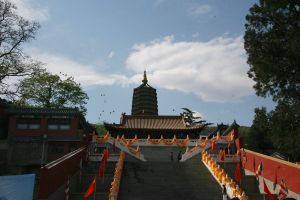Badachu
Located on the outskirts of Beijing, the sites were restored during the 1980's and have since become a popular destination, both for pilgrims and tourists.
The park is famous for its eight ancient Buddhist temples and monasterie: Changan Temple (Temple of Eternal Peace), Lingguang Temple (Temple of Divine Light), Sanshan Nunnery (Three-hill Nunnery), Dabei Temple (Temple of Great Mercy), Dragon Spring Nunnery (Dragon Spring Nunnery), Xiangjie Temple (The Temple of the Fragrant World), Pearl Cave (The Cave of Precious Pearl), and Zhengguo Temple.
Badachu Park is an attractive place to visit all year round. It has a pleasant temperate climate, remaining cool in summer and warm in winter. Visitors can stroll from one temple to another, enjoying the beautiful scenery and admiring the arbor and rare ancient trees. Some of these trees have been standing for over 6 centuries, but their roots and branches are still strong and in good shape. In September and October, when the leaves are turning red, crowds of tourists come to climb the mountains. There is a cable-car to the top of the hill.
While the park's natural beauty has long made it a magnet for people seeking tranquility, its ancient buildings and cave ensure its overriding atmosphere of timelessness. The individual temples and nunneries are as follows:
Changan Temple (Temple of Eternal Peace)
Located to the South of the park entrance and with its eastern aspect enclosed by a red wall, this temple was built in 1504. A brick wall opposite the temple's entrance bears the Chinese inscription "Arriving at Shangri-La". Temple features include two courtyards, three halls and, outside, two 100-year-old healthy lacebark pine trees.
Lingguang Temple (Temple of Divine Light)
This is the most prominent of the temples, though not the largest. Built between 766-779 during the Tang Dynasty, it is best known for its Dabei courtyard, a water-lily festooned gold-fish pool and pagoda. A gold-coated copper statue of the Sykyamuni Buddha, bequeathed by a Thai head monk, is enshrined in its main hall. A relic of the tooth of this Buddha was found in the ruins of Zhaoxian Pagoda, built in the Liao Dynasty, which was razed by foreign invaders. A replacement pagoda now houses the tooth.
Sanshan Nunnery (Three-hill Nunnery)
Built in 1151, this nunnery is surrounded by the Cui, Pinpo and Lushi Hills. It faces North, has one courtyard and a main building used to house a statue of Sakyamuni. An inscribed board above the door says "Big World", while a slab of marble at the foot of the door is known for its beautiful veins that have formed into a beautiful landscape. When water is sprayed on the marble, pictures of waterfalls, figures, animals and clouds appear. Couplets on the back door of the site's East hall were written by famed calligrapher, Chu Tunan.
Dabei Temple (Temple of Great Mercy)
Built before 1033 and with three courtyards, the Dabei Temple sits on a mountain slope that faces East. Emperor Kangxi wrote an inscription over the entrance door, through which stand four heavenly kings. In front of the Daxiong Hall, green bamboos planted during the Ming Dynasty still thrive.
Dragon Spring Nunnery (Dragon Spring Nunnery)
Situated to the north-west of the Dabei Temple, this nunnery is also known as the Dragon Hall. Built in 1425, it has five courtyards which are home to tall pines and cypresses which provide pleasant shade during the Summer. Entrance to the nunnery is through a small door which leads visitors to spring water which flows through a dragon's mouth into a pond. The nunnery's Tingquan Pavilion serves tea.
Xiangjie Temple (The Temple of the Fragrant World)
Largest of the temples, Xiangjie was built on Pingpo Hill around the year 760 during the Tang Dynasty. Its three doorways lead to five courtyards. One entrance displays an inscription, on a stone slab, written by the Emperor Qianlong. One courtyard contains an ancient pine which resembles a reclining dragon, thus attracting the name of "Dragon Pine".
Pearl Cave (The Cave of Precious Pearl)
Created in 1780 the cave, atop Pingpo Mount, is a perfect spot from which to view the sunrise and the panorama of Beijing. Emperor Qianlong wrote the inscriptions which can be found above the wooden archway to the hall, behind which the cave is located. Black and white gravel which forms part of the cave's stone walls resemble glittering pearls, hence the cave's name.
Zhengguo Temple
Credited with being the oldest of the eight temples, Zhengguo is thought to have been built in either the Tang or Sui dynasties. Facing South, it has two high stone steles on either side of the long entrance.
Badachu Park is an attractive place to visit all year round. The climate is cool in summer and warm in winter- the reverse of what is the usual experience in north China. An afternoon stroll from one temple to another, enjoying wonderful scenery and ancient trees, is a perfect escape from the hassle of modernity. Some of the trees have been standing for over 6 centuries, but their roots and branches are still strong and in good shape. The autumn is the most beautiful season, when red leaves welcome tourists that come here in droves. A cable car is also available for an easy, and lazy, approach to a great view from the mountain top.
